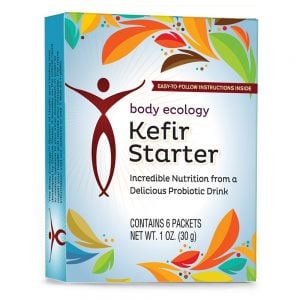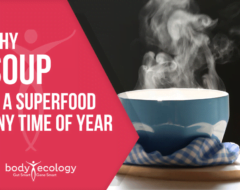Kefir Recipes: A Delicious Introduction to Fermented Dairy
. 
This traditionally fermented food has gone mainstream. In the health world, and even in the commercial food market, tart and creamy kefir is a big deal as its many health benefits are confirmed.
In recent years, scientists have praised this ancient fermented drink for its beneficial probiotic properties and for its high content of functional organic substances. Originating from the Balkans in Eastern Europe and in the Caucasus, we still enjoy drinking kefir today because of its distinct taste, rich nutrient profile, and possible antioxidant, anti-inflammatory, antifungal, antibacterial, and antitumor benefits.1 In 2015, Iranian scientists also explored kefir’s ability to address the global health epidemic of diabetes.2
Making basic kefir at home, using the Body Ecology Kefir Starter, makes for a nourishing and refreshing snack, but there’s so much more that you can do with this ancient health drink. Some of our favorite healing recipes include using kefir in salad dressing, smoothies, key lime ice cream, and more.
Kefir recipes harness beneficial microorganisms to transform your diet in exciting ways, offering vitamins, minerals, and potential revitalizing effects on your body. These recipes may improve digestion, boost immunity, and increase energy levels, among other potential benefits.
Body Ecology’s Top 7 Homemade Kefir Recipes
Because we believe that healthy foods should taste good too, we’ve rounded up our favorite recipes for this nourishing fermented drink:
1. Cool Kefir Dressing (No Oil)
Ingredients:
- 2 cups fresh kefir
- 1 heaping tablespoon fresh parsley, chopped
- 1 teaspoon Celtic sea salt
- 1 heaping tablespoon fresh chives, minced
- 1/4 teaspoon Herbamare
- 1 heaping tablespoon fresh lemon zest, finely chopped
- 1/2 teaspoon xanthan gum
- 1 heaping tablespoon fresh garlic, finely chopped
Directions:
- Combine all ingredients (except xanthan gum) and blend kefir recipe thoroughly.
- Slowly add xanthan gum and continue to blend kefir recipe until mixture thickens.
- Full flavor will develop after 6 to 8 hours.
2. Cultured Quinoa Milk
Ingredients:
- 2 cups raw quinoa
- 1 quart filtered water
- Pinch Celtic sea salt
- ¼ cup young coconut kefir or 1 packet of kefir starter
- Vanilla, BE Sweet, or organic mesquite powder (optional)
Directions:
- Soak quinoa overnight at room temperature in quart-sized covered glass container with a pinch of sea salt. Don’t refrigerate.
- Rinse and drain quinoa and put in blender. Add filtered water. Blend until very creamy. The quinoa milk will turn white.
- Drain quinoa pulp by using a nut-milk bag (found at natural grocers) or a fine-mesh strainer. (The quinoa pulp can be fermented or cooked and used in other recipes such as soups, croquettes, loaves, baby food, pet food, etc.)
- Pour strained quinoa milk into a sterile glass jar. Add ¼ cup young coconut kefir or 1 packet of kefir starter and seal jar.
- Set out to ferment at 72 to 76 degrees for 18 to 24 hours, and refrigerate until ready to use.
Drink as-is or add sweetener or flavors listed above. Add this “milk” to smoothies for a flavor and texture almost like yogurt. You can also add it to raw soups.
3. Dairy-Free Tzatziki
Ingredients:
- 2 cups fermented young coconut “pudding” or coconut kefir cheese
- 3 garlic cloves
- 2 tablespoons pumpkinseed oil
- ¼ cup freshly squeezed lemon juice
- 2 tablespoons fresh dill, chopped
- ½ cucumber, chopped
- 2 tablespoons organic, unfiltered olive oil
- 2 tablespoons coconut oil
- 2 tablespoons walnut oil
- Herbamare and/or Celtic sea salt to taste
Directions:
- Combine the fermented coconut meat, garlic, lemon juice, dill, and cucumber in a food processor.
- Blend until smooth.
- Combine the oils in a bowl then process with the coconut-meat mixture until emulsified.
- Season to taste with Herbamare and/or Celtic sea salt.
4. Key Lime Ice Cream
Ingredients:
- 4 to 5 cups coconut kefir cheese
- 3 limes, juiced
- 1/4 cup BE Sweet
- ⅛ teaspoon pure vanilla extract (alcohol-free), or a vanilla bean
- Pinch Celtic sea salt
Directions:
- In a Vitamix or food processor, combine coconut kefir cheese and lime juice, and blend for about 1 minute. Add BE Sweet, sea salt, and vanilla. Blend for another 30 seconds.
- Pour into freezer-safe container or ice cream maker, and freeze according to the manufacturer’s instructions.
If you do not have an ice cream maker, remove your ice cream from the freezer. Blend once more just before eating to get the creamiest consistency.
5. Lemon Apple Yogurt Parfait
Ingredients:
- 2 cups of young coconut kefir cheese
- 1 Granny Smith green apple, cored, peeled, diced
- 1 teaspoon agar
- 2 tablespoons BE Sweet
- ½ cup filtered water
- 1 tablespoon freshly squeezed lemon juice
- 1 teaspoon lemon zest, finely grated
- Mint leaves for garnish
Directions:
- Combine 1 cup of coconut kefir cheese, Granny Smith apple in a high-speed blender or food processor. Then, blend until creamy. Move to a mixing bowl.
- Put the remaining coconut kefir cheese in the blender jar (no need to wash). Add BE Sweet, lemon juice, and lemon zest. Then, blend until creamy. Move to a separate mixing bowl.
- Boil ½ cup of filtered water. Then, turn off heat, add agar flakes, and stir until dissolved. Quickly add half of the agar gelatin to each bowl and stir. You can re-blend each fruit/cream if you like.
- Lastly, spoon half of the lemon cream into 4 wine glasses, then top with half of the green apple cream. Repeat with the remaining lemon and green apple creams. Refrigerate for 20 minutes before serving.
6. Real Sour Cream
Ingredients:
- 1 pint of raw, grass-fed cream
- 1 packet of kefir starter
Directions:
- Pour the cream into a quart-size jar and whisk in a packet of the Body Ecology Kefir Starter Culture.
- Allow this mixture to sit somewhere warm for 1–2 days.
- Smell and taste the cream, making sure that it is “sour.” This ensures that all the milk sugars have been consumed by the beneficial microflora. Depending on the temperature of your home, the time for this process will vary.
- Place the fermented cream in the refrigerator. Use or allow it to ferment longer in the refrigerator, if you wish.
To use, briefly whisk the cream until it thickens. You can also thicken the cream by simply shaking it in the jar.
7. Spectacular Kefir Smoothie
Make this kefir recipe with the freshest milk possible and add as many of the following ingredients as desired.
Ingredients:
- 1 teaspoon of unrefined flaxseed oil
- Lecithin, which aids fat digestion, to taste
- Fiber, such as Nutri-Flax
- Splash of CocoBiotic (friendly bacteria)
- Natural flavorings or herbs such as BE Sweet, nutmeg, cinnamon, non-alcoholic vanilla, or natural fruit flavoring
- Fresh or frozen organic fruits, strawberries, raspberries, kiwi, blueberries, black currants, sour cherries, cranberries, or papaya
- 2 scoops Vitality SuperGreen
Directions:
- Blend kefir recipe together for a delicious, nutritious breakfast, lunch, or snack and enjoy!
Health Starts in the Kitchen
These fresh and flavorful kefir recipes are just a small sample of what you can find in our full collection, in the new The Body Ecology Living Cookbook written by Donna Gates. A pioneer of fermented foods, Donna was inspired to write this cookbook to share all of her favorite recipes based on the simple Body Ecology principle that healing foods can still be enjoyable and delicious.
“My fascination with the ability to heal with food began early in my life. I studied to be a dietitian in college and found it to be too one-sided — lots of science but no real focus on the wisdom of Nature. My own kitchen soon became my laboratory. And the path that I would eventually embark upon would lead me to rediscover ancient healing foods and ultimately discover the key to unlocking the body’s innate intelligence to heal,” Donna explains.
What To Remember Most About This Article:
As if kefir on its own wasn’t tasty enough, we’ve got enough healthy and healing recipes to keep you busy for the rest of the year. Most of these kefir recipes can be found in the new Body Ecology Living Cookbook, along with other fresh favorites, like our smoothies, high-protein salads, hearty soups, meat and grain-like seed entrées, and of course, our fermented foods. Dairy kefir, coconut water kefir, and kefir cheese can all be made at home using our simple tutorial found here.
There’s a reason traditional kefir is a staple on the Body Ecology Diet.
Research has confirmed the healing properties of this ancient fermented drink, and we’ve seen the same restorative benefits in our own lives. If you master one traditionally fermented food at home, let it be this: Kefir is easy to make at home using the Body Ecology Kefir Starter and can be nourishing for the whole family. Understanding the basics will prepare you to explore a variety of recipes that bring delicious healing to your kitchen.
REFERENCES:
- Prado MR, Blandón LM, Vandenberghe LP, Rodrigues C, Castro GR, Thomaz-Soccol V, Soccol CR. Milk kefir: composition, microbial cultures, biological activities, and related products. Front Microbiol. 2015 Oct 30;6:1177. doi: 10.3389/fmicb.2015.01177.
- Ostadrahimi A, Taghizadeh A, Mobasseri M, Farrin N, Payahoo L, Beyramalipoor Gheshlaghi Z, Vahedjabbari M. Effect of probiotic fermented milk (kefir) on glycemic control and lipid profile in type 2 diabetic patients: a randomized double-blind placebo-controlled clinical trial. Iran J Public Health. 2015 Feb;44(2):228-37.












